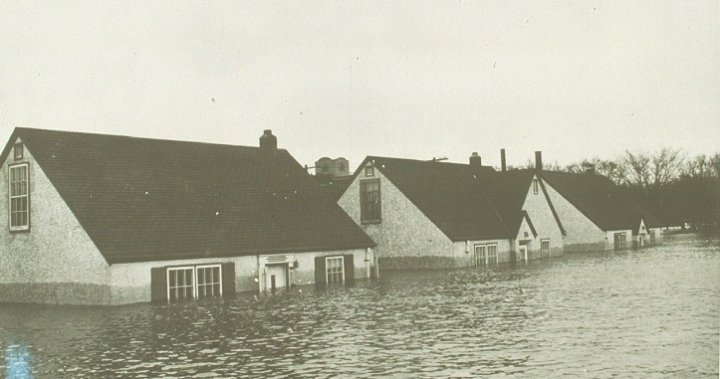As emergency crews fight wildfires across the province this year, three-quarters of a century ago, Winnipeg and Manitoba were dealing with a much different natural disaster.
It was 75 years ago this spring that Winnipeg was in crisis mode, surrounded and submerged by floodwaters.
An aerial view of Winnipeg during the flood of 1950.
Courtesy / City of Winnipeg Archives
A cornerstore surrounded by floodwaters.
Courtesy / City of Winnipeg Archives
Annabella Street in Winnipeg underwater during the flood of 1950.
Courtesy / City of Winnipeg Archives
The flood of 1950 marked one of the most devastating natural disasters within city limits, triggered by the melting of heavy spring snow and then heavy rainfall. The Red River peaked at 9.2 metres at James Avenue in Winnipeg in May 1950. It was the worst flood in the Red River Valley since 1861.
“That particular April there was two times as much snow as we normally had, and it was also warm,” said Greg Agnew, the president of Heritage Winnipeg.
“It hit St. Norbert and Fort Garry first, so the University of Manitoba ended up being under water.”
The University of Manitoba’s Fort Garry campus during the flood of 1950.
Credit / University of Manitoba Digital Archives
Floodwaters reached up to the second storey of homes, the rush hour commute through city streets saw boats and canoes replace vehicles, and downtown Winnipeg landmarks, power stations, schools and hospitals were surrounded by rising water levels, dikes and causeways.
Get breaking National news
For news impacting Canada and around the world, sign up for breaking news alerts delivered directly to you when they happen.
“It’s kind of surreal to think of people just paddling around,” Agnew said.
Winnipeg’s flood of 1950.
Courtesy / City of Winnipeg Archives
The causeway to the Rover Street station during the flood of 1950.
Courtesy / City of Winnipeg Archives
Flooded downtown Winnipeg streets near the Manitoba legislative building.
Courtesy / Province of Manitoba Archives
People fleeing their homes via a raft.
Courtesy / City of Winnipeg Archives
Those moments are carefully documented at the City of Winnipeg Archives through newspaper clippings, minutes of emergency council and committee meetings, and countless photos, many of which have been recently digitized.
“The ones that most people are interested in are the ones that kind of show water absolutely everywhere. About one-eighth of the city was underwater during that time,” said Jarad Buckwold, a digital archivist for the City of Winnipeg.
A man wades through a flooded greenhouse.
Courtesy / City of Winnipeg Archives
A group of men work to get a fence out of the propeller of a piece of flood-fighting equipment.
Courtesy / City of Winnipeg Archives
Residents get into a boat to leave their Wellington Crescent home.
Courtesy / City of Winnipeg Archives
A state of emergency was declared and the Red Cross and the military were brought in to assist with evacuations.
“The Red Cross set up in the civic auditorium on Vaughan Street and they sort of turned that into their flood relief HQ,” Buckwold said.
“Approximately 100,000 people evacuated during the flood, which was about a third of the size of Winnipeg at the time.”
A young evacuee with a puppy in the Red Cross’s evacuee headquarters during the flood of 1950.
Courtesy / City of Winnipeg Archives
The Red Cross hands out packs of cigarettes to workers building dikes during Winnipeg’s flood of 1950.
Courtesy / City of Winnipeg Archives
The flood, which lasted 51 days, destroyed approximately 10,000 homes and damaged 5,000 buildings. Four of the city’s 11 bridges were also damaged beyond repair and needed to be replaced. It’s estimated the flood caused about $125.5 million in damages, which would be about $1 billion today.
The flood prompted the construction of the floodway during the 1960s, then known as “Duff’s Ditch” in recognition of then-premier Duff Roblin. The province estimates that since 1968, the floodway has prevented tens of billions of dollars in flood damage.
Buckwold says it’s important to keep these events well-documented, as the response is something that can be learned from for decades to come.
“Flooding will happen again, it always has, it probably always will,” Buckwold said. “And by getting a sense of how it was dealt with, it will help us in the future to better prepare and hopefully prevent any sort of disaster on that scale from happening.”
© 2025 Global News, a division of Corus Entertainment Inc.


